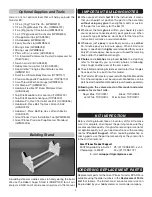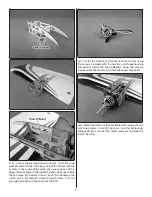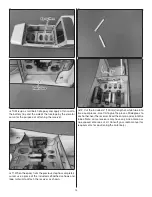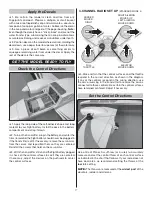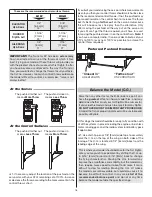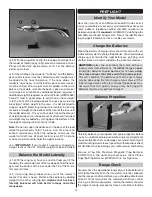
18
These are the recommended control surface throws:
ELEVATOR
HIGH
LOW
3/8"
[ 9.5 mm ]
20°
1/4"
[ 6.4 mm]
14°
7/16"
[11mm ]
21°
1/4"
[ 6 mm ]
11°
1-1/16"
[ 27 mm ]
30°
13/16"
[ 21mm ]
23°
RUDDER
AILERONS
Up & Down
Up & Down
Right & Left
IMPORTANT:
The Twinstar EP has been
extensively
fl own and tested to arrive at the throws at which it fl ies
best. Flying your model at these throws will provide you
with the greatest chance for successful fi rst fl ights. If, after
you have become accustomed to the way the Twinstar
fl ies, you would like to change the throws to suit your taste,
that is fi ne. However, too much control throw could make
the model diffi cult to control, so remember, “more is not
always better.”
The pushrod farther out
means
More Throw
The pushrod closer in
means
Less Throw
The pushrod farther out
means
Less Throw
The pushrod closer in
means
More Throw
At the Servos
At the Control Surfaces
❏
1. If necessary, adjust the location of the pushrod on the
servo arms with your ATVs remaining set at 100%. Increase
or decrease the throw according to the measurements in the
control throws chart.
If you built your model using the servo arm hole measurements
given to you then your control throws should match or be close
to the recommended control throws. If not, the pushrod may
be moved inward on the control horn to increase the throw,
but it’s better to go
farther out
on the servo arm because
this will introduce less free play than the alternative. Only
after moving the pushrod all the way out on the servo arm,
if you still can’t get the throw required, you’ll have to resort
to moving the pushrod closer in on the control horn.
Note:
If
you have a computer radio, it is always desirable to set your
ATVs to 100% (or as near 100% as possible to achieve the
control throw required).
“Closest in”
on servo arm
“Farthest out”
on control horn
Preferred Pushrod Hookup
Balance the Model (C.G.)
More than any other factor, the
C.G.
(balance point) can
have the
greatest
effect on how a model fl ies, and may
determine whether or not your fi rst fl ight will be successful.
If you value this model and wish to enjoy it for many fl ights,
DO NOT OVERLOOK THIS IMPORTANT PROCEDURE.
A model that is not properly balanced will be unstable and
possibly unfl yable.
At this stage the model should be in ready-to-fl y condition with
all of the systems in place including the engine or brushless
motor, landing gear, and the radio system (and battery pack
if applicable).
❏
1. Use a felt-tip pen or 1/8" [3mm]-wide tape to accurately
mark the C.G. on the top of the wing on both sides of the
fuselage. The C.G. is located 2-1/2" [64mm] back from the
leading edge of the wing.
This is where your model should balance for the fi rst fl ights.
Later, you may wish to experiment by shifting the C.G. up
to 5/16" [8mm] forward or 5/16" [8mm] back to change
the fl ying characteristics. Moving the C.G. forward may
improve the smoothness and stability, but the model may
then require more speed for takeoff and make it more
diffi cult to slow for landing. Moving the C.G. aft makes
the model more maneuverable, but could also cause it to
become too diffi cult to control. In any case,
start at the
recommended balance point
and do not at any time
balance the model outside the specifi ed range.

